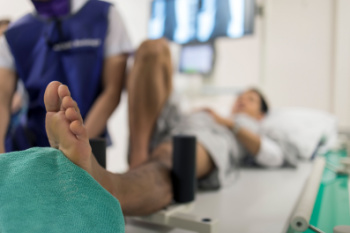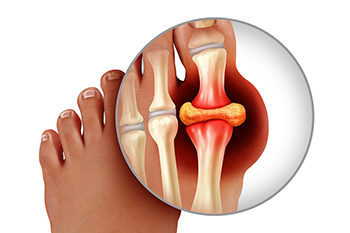Items filtered by date: August 2025
Do You Suffer From Painful Feet?
Twists and Sprains on the Trail

Trail running exposes the feet and ankles to forces and hazards not found on smooth pavement. Uneven ground, hidden roots, and shifting rocks can quickly lead to rolled ankles, strained ligaments, or stress fractures. The constant changes in slope and surface demand rapid adjustments in foot placement, increasing the chance of missteps that overstretch tendons or tear soft tissue. Repeated downhill impact can bruise the heel or inflame structures like the plantar fascia. In some cases, sudden landings on unstable surfaces cause foot bone injuries that require weeks of recovery. Trail conditions such as mud, loose gravel, and water crossings can make slips more likely, leading to sharp impacts or twisting falls. Because these injuries can escalate and lead to long-term complications if ignored, it is suggested that you visit a podiatrist for any lingering pain, swelling, or difficulty bearing weight after a run.
Ankle and foot injuries are common among athletes and in many sports. They can be caused by several problems and may be potentially serious. If you are feeling pain or think you were injured in a sporting event or when exercising, consult with Yvonne Umezurike, DPM from Umez Podiatry. Our doctor will assess your condition and provide you with quality foot and ankle treatment.
Common Injuries
The most common injuries that occur in sporting activities include:
- Achilles Tendonitis
- Achilles Tendon Rupture
- Ankle Sprains
- Broken Foot
- Plantar Fasciitis
- Stress Fractures
- Turf Toe
Symptoms
Symptoms vary depending upon the injury and in some cases, there may be no symptoms at all. However, in most cases, some form of symptom is experienced. Pain, aching, burning, bruising, tenderness, tightness or stiffness, sensation loss, difficulty moving, and swelling are the most common symptoms.
Treatment
Just as symptoms vary depending upon the injury, so do treatment options. A common treatment method is known as the RICE method. This method involves rest, applying ice, compression and elevating the afflicted foot or ankle. If the injury appears to be more serious, surgery might be required, such as arthroscopic or reconstructive surgery. Lastly, rehabilitation or therapy might be needed to gain full functionality in the afflicted area. Any discomfort experienced by an athlete must be evaluated by a licensed, reputable medical professional.
If you have any questions please contact our offices located in Baltimore, MD and Washington DC . We offer the newest diagnostic and treatment technologies for all your foot and ankle needs.
Different Types of Foot Stress Fractures

Stress fractures in the foot occur when repeated stress causes small cracks in bones that support weight during walking, running, or standing for a long time. These injuries often affect the metatarsals, especially the second and third, which are slender bones near the middle of the foot that bear significant force during activity. The calcaneus, or heel bone, can also develop stress fractures from impact, while the navicular bone on the top midfoot is prone to injury during jumping or sprinting. Less commonly, the talus bone in the ankle joint may become injured. Symptoms of stress fractures include pain during weight-bearing that eases with rest, along with tenderness and swelling in the affected area. Stress fractures can be the result of muscle fatigue, sudden increases in activity, or bones weakened by underlying conditions. A podiatrist can diagnose a stress fracture using a physical exam and imaging, such as an MRI scan, and may recommend rest, immobilization, or surgery, in severe cases. If you are experiencing symptoms of a foot stress fracture, it is suggested that you schedule an appointment with a podiatrist for an accurate diagnose and appropriate treatment.
Activities where too much pressure is put on the feet can cause stress fractures. To learn more, contact Yvonne Umezurike, DPM from Umez Podiatry. Our doctor can provide the care you need to keep your pain free and on your feet.
Dealing with Stress Fractures of the Foot and Ankle
Stress fractures occur in the foot and ankle when muscles in these areas weaken from too much or too little use. The feet and ankles then lose support when walking or running from the impact of the ground. Since there is no protection, the bones receive the full impact of each step. Stress on the feet can cause cracks to form in the bones, thus creating stress fractures.
What Are Stress Fractures?
Stress fractures occur frequently in individuals whose daily activities cause great impact on the feet and ankles. Stress factors are most common among:
- Runners
- People affected with Osteoporosis
- Tennis or basketball players
- Gymnasts
- High impact workouts
Symptoms
Pain from the fractures occur in the area of the fractures and can be constant or intermittent. It will often cause sharp or dull pain with swelling and tenderness. Engaging in any kind of activity which involves high impact will aggravate pain.
If you have any questions please contact our offices located in Baltimore, MD and Washington DC . We offer the newest diagnostic and treatment technologies for all your foot and ankle needs.
Changes in Foot and Ankle Function With Age

As the body ages, the structure and function of the feet and ankles begin to shift. Natural wear and tear, along with a lifetime of activity, can lead to decreased flexibility, weaker muscles, and thinning of the protective fat pads that cushion each step. Joint cartilage may become worn, and ligaments may lose some of their elasticity, making balance and movement less steady. These changes can affect posture, walking patterns, and stability. Even small changes in foot shape or ankle strength can increase the risk of falls or discomfort. Wearing supportive footwear, regular movement, and attention to foot health can help maintain mobility. If walking becomes more difficult or foot pain increases with age, it is suggested that you consult a podiatrist to address these concerns and improve comfort during daily activities.
If you have any concerns about your feet, contact Yvonne Umezurike, DPM from Umez Podiatry. Our doctor can provide the care you need to keep you pain-free and on your feet.
Biomechanics in Podiatry
Podiatric biomechanics is a particular sector of specialty podiatry with licensed practitioners who are trained to diagnose and treat conditions affecting the foot, ankle and lower leg. Biomechanics deals with the forces that act against the body, causing an interference with the biological structures. It focuses on the movement of the ankle, the foot and the forces that interact with them.
A History of Biomechanics
- Biomechanics dates back to the BC era in Egypt where evidence of professional foot care has been recorded.
- In 1974, biomechanics gained a higher profile from the studies of Merton Root, who claimed that by changing or controlling the forces between the ankle and the foot, corrections or conditions could be implemented to gain strength and coordination in the area.
Modern technological improvements are based on past theories and therapeutic processes that provide a better understanding of podiatric concepts for biomechanics. Computers can provide accurate information about the forces and patterns of the feet and lower legs.
Understanding biomechanics of the feet can help improve and eliminate pain, stopping further stress to the foot.
If you have any questions please feel free to contact our offices located in Baltimore, MD and Washington DC . We offer the newest diagnostic and treatment technologies for all your foot and ankle needs.
Recognizing the Signs and Seeking Relief From Gout

Gout is a form of inflammatory arthritis caused by a buildup of uric acid crystals in the joints, most often affecting the big toe. This condition can result from a diet high in purines, kidney problems, or genetic factors. Symptoms include intense joint pain, swelling, redness, warmth, and, in some cases, fever and chills. Over time, repeated attacks may lead to joint deformity and lasting damage. A podiatrist can help by diagnosing the condition, offering medication, lifestyle guidance, and managing flare-ups to prevent progression. If you notice intense, sudden pain or swelling in your big toe joint, it is suggested that you consult a podiatrist who can accurately diagnose the problem, and help you to manage pain.
Gout is a foot condition that requires certain treatment and care. If you are seeking treatment, contact Yvonne Umezurike, DPM from Umez Podiatry. Our doctor will treat your foot and ankle needs.
What Is Gout?
Gout is a type of arthritis caused by a buildup of uric acid in the bloodstream. It often develops in the foot, especially the big toe area, although it can manifest in other parts of the body as well. Gout can make walking and standing very painful and is especially common in diabetics and the obese.
People typically get gout because of a poor diet. Genetic predisposition is also a factor. The children of parents who have had gout frequently have a chance of developing it themselves.
Gout can easily be identified by redness and inflammation of the big toe and the surrounding areas of the foot. Other symptoms include extreme fatigue, joint pain, and running high fevers. Sometimes corticosteroid drugs can be prescribed to treat gout, but the best way to combat this disease is to get more exercise and eat a better diet.
If you have any questions, please feel free to contact our offices located in Baltimore, MD and Washington DC . We offer the newest diagnostic and treatment technologies for all your foot care needs.




